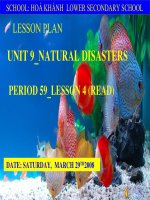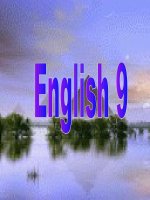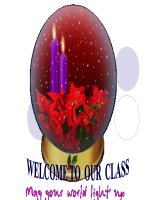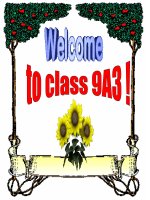Unit 9- Lesson 4: Read
Bạn đang xem bản rút gọn của tài liệu. Xem và tải ngay bản đầy đủ của tài liệu tại đây (78.65 KB, 6 trang )
<span class='text_page_counter'>(1)</span><div class='page_container' data-page=1>
<b>---o0o---GIÁO ÁN LÊN LỚP</b>
<b>MON-HOC: TIẾNG ANH - LỚP 9</b>
<b>Người soạn</b>
: Vũ Thị Hồng Vân
<b>Ngày soạn</b>
: 13/04/2017
<b>Ngày duyệt</b>
: 13/04/2017
</div>
<span class='text_page_counter'>(2)</span><div class='page_container' data-page=2>
<b>UNIT 9- LESSON 4: READ</b>
<b>I. MỤC TIÊU</b>
<b>1. Về kiến thức</b>
Students will be able to Get general background information on some common natural disasters
such as earthquakes, tidal waves, typhoon, volcanoes and tornadoes
<b>2. Về kỹ năng</b>
Reading skill
<b>3. Về thái độ</b>
Interested in learning English
<b>II. CHUẨN BỊ CỦA GIÁO VIÊN VÀ HỌC SINH</b>
<b>1. Giáo viên</b>
Textbook, lesson plan, posters
<b>2. Học sinh</b>
Textbook
<b>III. PHƯƠNG PHÁP</b>
Group work
<b>IV. TIẾN TRÌNH GIỜ DẠY</b>
<b>1. Ổn định lớp (thời gian: 1 phút):</b>
How are you today?
<b>2. Kiểm tra bài cũ (thời gian: 5 phút):</b>
<b>Warm up:</b><i> </i>
Matching and chatting:
- Show four pictures on page 74 and ask students to match them with four words: snowstorm,
earthquake, volcano, typhoon.
- Give students some questions about the four natural disasters.
<i>. How do you know it is a snowstorm/ earthquake/ a volcano/ a typhoon?</i>
<i>. Have you ever experienced any of these natural disasters? What happened? How did you feel?</i>
<b>3. Giảng bài mới:</b>
<b>NỘI</b>
<b>DUN</b>
<b>G</b>
<b>THỜ</b>
<b>I</b>
<b>GIA</b>
<b>N</b>
<b>HOẠT ĐỘNG DẠY HỌC</b>
<b>GHI BẢNG</b>
<b>Hoạt động của giáo viên</b> <b>Hoạt động của học sinh</b>
</div>
<span class='text_page_counter'>(3)</span><div class='page_container' data-page=3>
lesso
n phút
1. Vocabulary :
<i>1. ( picture )</i>
<i> 2. ( synonym: quick,</i>
<i>sudden )</i>
<i> 3. ( picture)</i>
<i> 4. ( picture )</i>
<i> 5. ( visual )</i>
<i> 6. ( change to )</i>
<i> 7. ( picture )</i>
Sts : - listen.
- l i s t e n a n d r e p e a t
( c h o r a l l y t h e n
individually).
- copy.
* Checking vocabulary:
Rub out and remember
- Rub out the words one at
time, each time you torub
out the word in English,
point to the Vietnemese
t r a n s l a t i o n a n d a s k
students to repeat again.
When all the English
words are rubbed out, go
through the Vietnamese
list and get students to call
out the English words.
2. True - False statements
predictions
- Set the scene: <i>you are</i>
<i>going to read a passage</i>
<i>about 5 disasters that we</i>
<i>have mentioned earlier.</i>
<i>There are 6 statements</i>
<i>about the information of</i>
<i>some natural disasters. All</i>
<i>of you have to read them</i>
<i>and guess whether they</i>
<i>are true or false.</i>
- Hang the poster of T/F
statements ( on page 79)on
the board.
1. Vocabulary :
<i>1. ( picture )</i>
<i> 2. ( synonym: quick, sudden )</i>
<i> 3. ( picture)</i>
<i> 4. ( picture )</i>
<i> 5. ( visual )</i>
<i> 6. ( change to )</i>
<i> 7. ( picture )</i>
Sts : - listen.
- listen and repeat (chorally then
individually).
- copy.
* Checking vocabulary: Rub out and
remember
- Rub out the words one at time, each
time you torub out the word in
English, point to the Vietnemese
translation and ask students to repeat
again. When all the English words are
r u b b e d o u t , g o t h r o u g h t h e
Vietnamese list and get students to
call out the English words.
2. True - False statements predictions
- Set the scene: <i>you are going to read</i>
<i>a passage about 5 disasters that we</i>
<i>have mentioned earlier.</i> <i>There are 6</i>
<i>statements about the information of</i>
<i>some natural disasters. All of you</i>
<i>have to read them and guess whether</i>
<i>they are true or false.</i>
- Hang the poster of T/F statements (
on page 79)on the board.
- Get students to work in pairs to
guess which statements are true and
which are false.
- Give feedback.
<b>II. While Reading :</b>
1. Reading and checking
- Have students read the text on page
78 and check their prediction.
<b>Started</b>
Answer keys:
Snowstorm
-picture 1.
earthquake
-picture 2.
v o l c a n o
-picture 3.
t y p h o o n
-picture 4.
<b>2. Vocabulary</b>
<b>:</b>
- Tidal wave (
n ): sóng thần
- hurricane =
c y c l o n e =
t y p h o o n ( n )
bão nhiệt đới
- tornado (n)
cơn lốc xoáy
- erupt ( v)
phun (núi lửa)
- suck up ( v ):
hút lên
- shift ( n ): sự
chuyển dịch,
sự thay đổi
f u n n e l
-shaped ( adj ):
có hình phễu
</div>
<span class='text_page_counter'>(4)</span><div class='page_container' data-page=4>
- Get students to work in
p a i r s t o g u e s s w h i c h
statements are true and
which are false.
- Give feedback.
<b>II. While Reading :</b>
1. Reading and checking
- Have students read the
text on page 78 and check
their prediction.
Get students to correct
false statements.
2. Complete the sentences:
- Have students work in
pairs and complete the
sentences in exercise 5b
on page 79.
G e t s t u d e n t s t o c o r r e c t f a l s e
statements.
2. Complete the sentences:
- Have students work in pairs and
complete the sentences in exercise 5b
on page 79.
<b>III. Post Reading :</b>
Asking and Answering:
- Divide the class into four groups.
- Have students read the text again.
- Group 1 ask a question, group 2, 3,
4 answer it.
<b>3. Read :</b>
a ) T r u e o r
False
<i>Answer key :</i>
<i>1. T</i>
<i>2. T</i>
<i>3. F A huge</i>
<i>t i d a l w a v e</i>
<i>t r a v e l e d</i>
<i>from Alaska</i>
<i>t</i> <i>o</i>
<i>Ccalifornia.</i>
<i>4. T</i>
<i>5 . F T h e</i>
<i>eruption of</i>
<i>M o u n t</i>
<i>Pinatubo is</i>
<i>the world’s</i>
<i>l a r g e s t</i>
<i>v o l c a n i c</i>
<i>eruption in</i>
<i>more than 50</i>
<i>years.</i>
<i>6. T</i>
b) Complete
the sentences:
</div>
<span class='text_page_counter'>(5)</span><div class='page_container' data-page=5>
<b>III. Post Reading :</b>
Asking and Answering:
- Divide the class into four
groups.
- Have students read the
text again.
- Group 1 ask a question,
group 2, 3, 4 answer it.
- Group 2 ask another
question, group 1, 3, 4
answer.
- Go on until the four
groups ask their questions
* Possible answers:
<i>1. Why do people call the</i>
<i>Pacific Rim “Ring of</i>
<i>Fire”?</i>
<i>- B e c a u s e 9 0 % o f</i>
<i>earthquakes occur around</i>
<i>the Pacific Rim.</i>
<i>2. What will happen when</i>
<i>there is an abrupt shift in</i>
<i>the underwater movement</i>
<i>of the earth?</i>
<i>- Tidal waves will happen.</i>
<i>3. What does “typhoon”</i>
<i>mean?</i>
<i>- It means “big wind”.</i>
<i>4 . C a n w e p r e d i c t a</i>
<i>volcano?</i>
<i>- Yes. The scientists can</i>
<i>w a r n u s a b o u t t h e</i>
<i>eruption.</i>
- Group 2 ask another question, group
1, 3, 4 answer.
- Go on until the four groups ask their
questions
* Possible answers:
<i>1. Why do people call the Pacific Rim</i>
<i>“Ring of Fire”?</i>
<i>- Because 90% of earthquakes occur</i>
<i>around the Pacific Rim.</i>
<i>2. What will happen when there is an</i>
<i>abrupt shift in the underwater</i>
<i>movement of the earth?</i>
<i>- Tidal waves will happen.</i>
<i>3. What does “typhoon” mean?</i>
<i>- It means “big wind”.</i>
<i>4. Can we predict a volcano?</i>
<i>- Yes. The scientists can warn us</i>
<i>about the eruption.</i>
<i>earthquakes</i>
<i>occur</i>
<i>around the</i>
<i>Pacific Rim.</i>
<i>2. During the</i>
<i>earthquake</i>
<i>i n K o b e ,</i>
<i>many people</i>
<i>were killed</i>
<i>when homes,</i>
<i>office blocks</i>
<i>a</i> <i>n</i> <i>d</i>
<i>h i g h w a y s</i>
<i>collapsed.</i>
<i>3 . A t i d a l</i>
<i>w a v e c a n</i>
<i>only occur</i>
<i>when there is</i>
<i>a n a b r u p t</i>
<i>shift in the</i>
<i>underwater</i>
<i>movement of</i>
<i>the Earth.</i>
<i>4 .</i> <i> I n</i>
<i>Astralia, a</i>
<i>t r o p i c a l</i>
<i>s t o r m i s</i>
<i>known as a</i>
<i>cyclone.</i>
<i>5</i> <i>.</i>
</div>
<span class='text_page_counter'>(6)</span><div class='page_container' data-page=6>
<b>4. Củng cố (thời gian: 2 phút):</b>
- Reading a text about natural disasters in the world.
<b>5. Hướng dẫn tự học (thời gian: 2 phút):</b>
- Have students write the exercise 5b into their notebooks, using their ideas.
<b>V. RÚT KINH NGHIỆM</b>
Good lesson!
<i>path.</i>
</div>
<!--links-->









